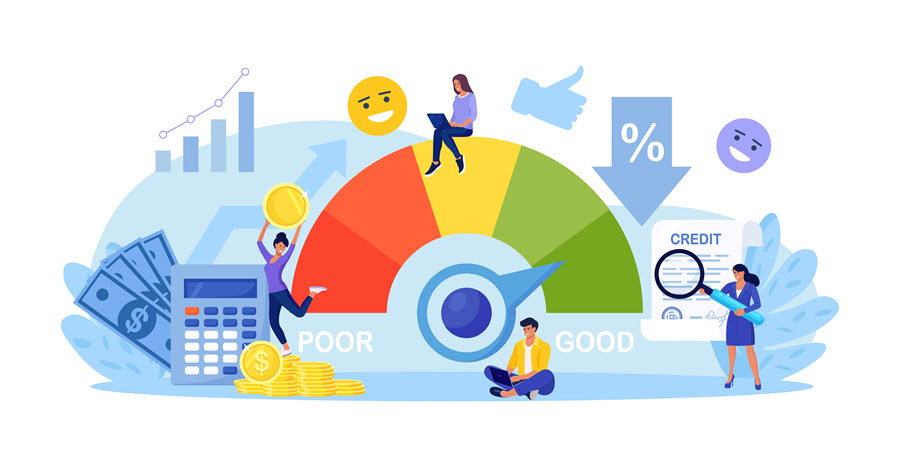When buying or refinancing a home, many people focus on the purchase price or the…
Unlocking the Best Mortgage Rates: Strategies and Insights
Navigating the landscape of mortgage rates can be a daunting task for potential homeowners. Understanding the key factors that influence these rates and adopting strategic actions are crucial in securing the best mortgage deal.
This comprehensive guide delves into the essential elements that affect mortgage rates and outlines practical steps borrowers can take, including the advantages of working with a reputable mortgage broker like Six Pillar Lending. Our aim is to empower you with knowledge and tools to make informed decisions in your home-buying journey.
Understanding Mortgage Rates
Overview of Mortgage Rates
Mortgage rates are a critical aspect of home loans, representing the interest rate charged on the amount borrowed to purchase a property. They are expressed as a percentage and can vary depending on the type of loan, the lender, and broader economic conditions. The mortgage rate directly impacts the cost of borrowing money for a home, influencing both the monthly payments and the total amount paid over the life of the loan.
Significance in Home Loans
- Monthly Payment Amount: The mortgage rate determines the interest portion of your monthly mortgage payment. A lower rate means lower monthly payments, making the loan more affordable.
- Total Cost of Borrowing: Over the duration of a mortgage, which typically spans 15 to 30 years, even a small difference in the interest rate can significantly affect the total amount paid. A higher rate results in a higher total cost of borrowing.
- Loan Affordability: Mortgage rates can influence the size of the loan you can afford. Lower rates can make larger, more expensive homes more accessible, as they reduce the monthly payment amount.
- Refinancing Decisions: Current mortgage rates are a crucial factor for homeowners considering refinancing their existing mortgage. A lower rate than what they currently have can justify the decision to refinance.
- Real Estate Market Dynamics: The level of mortgage rates can affect the overall real estate market. Lower rates generally increase demand for homes, as more people can afford to borrow. Conversely, higher rates can cool down a heated market.
- Equity Building: With a lower mortgage rate, a greater portion of each payment goes towards paying down the principal rather than the interest, allowing homeowners to build equity in their property faster.
Key Takeaways
- Mortgage rates are pivotal in determining the cost and affordability of a home loan.
- They influence monthly payments, the total interest paid, and the speed at which equity is built in the property.
- Understanding mortgage rates and how they fit into the broader economic context is crucial for potential homebuyers and those considering refinancing.
Mortgage rates are not just numbers; they are influential factors that shape your home-buying experience and financial planning. Therefore, staying informed and seeking the best possible rate is essential for anyone taking on a mortgage.
Factors Influencing Mortgage Rates
Mortgage rates are influenced by a complex interplay of economic factors, with key influences coming from broader economic indicators, inflation, and policies set by the Federal Reserve. Understanding these influences can help in anticipating trends in mortgage rates.
Economic Indicators:
- Gross Domestic Product (GDP): The overall health of the economy, often measured by GDP, can influence mortgage rates. A strong economy typically leads to higher rates as lenders anticipate more demand for credit and potential inflation.
- Employment Rates: High employment levels can lead to increased demand for housing, potentially pushing up mortgage rates. Conversely, high unemployment can lead to lower rates as a means to stimulate economic activity.
- Consumer Spending: When consumer spending is high, it can signal a robust economy, which may lead to higher mortgage rates. Conversely, lower consumer spending might indicate economic challenges, potentially leading to lower rates.
Inflation:
- Direct Impact: Inflation erodes the purchasing power of money. When inflation is high, lenders typically raise mortgage rates to compensate for the decreased value of future payments they will receive.
- Expectations of Future Inflation: Even the expectation of future inflation can influence current mortgage rates. If lenders believe that inflation will rise, they might increase rates in advance.
Federal Reserve Policies:
- Federal Funds Rate: While the Federal Reserve doesn’t set mortgage rates directly, its adjustments to the federal funds rate can influence them. This rate is what banks charge each other for overnight loans and influences the prime rate, which in turn affects mortgage rates.
- Quantitative Easing: The Fed can also influence rates through quantitative easing, which involves the purchase of long-term securities to inject money into the economy. This can lead to lower mortgage rates by increasing the supply of money and encouraging lending.
- Economic Outlook Statements: The Federal Reserve’s outlook on the economy, communicated through meetings and statements, can also impact mortgage rates. If the Fed signals concerns about inflation or economic overheating, it might lead to an increase in rates.
Other Factors:
- Global Economic Conditions: International economic events can also impact U.S. mortgage rates. For instance, if foreign investors seek the safety of U.S. Treasury bonds in times of global uncertainty, this demand can drive down yields and, indirectly, mortgage rates.
- Housing Market Conditions: The state of the housing market itself can influence mortgage rates. In a very active market with a high demand for mortgages, rates may increase. Conversely, in a slow market, lenders might lower rates to attract more borrowers.
Mortgage rates are dynamic and influenced by a combination of domestic economic health, inflation levels, Federal Reserve policies, and broader global economic trends. Understanding these factors can help borrowers and investors anticipate changes in mortgage rates and make more informed decisions.
Importance of Credit Score and Debt-to-Income Ratio
The Role of Credit Score
A credit score is a numerical representation of a borrower’s creditworthiness, based on their credit history. It plays a crucial role in determining mortgage rates offered by lenders. The relationship between credit scores and mortgage rates can be understood in terms of risk assessment by lenders.
High Credit Score and Better Mortgage Rates
- Lower Risk for Lenders: A high credit score indicates that the borrower has a history of managing their credit responsibly. This translates to a lower risk for lenders, as the borrower is more likely to make timely payments.
- Better Loan Terms: Lenders often reserve their most favorable loan terms, including lower interest rates, for borrowers with high credit scores (typically 740 or above). These borrowers are seen as less likely to default on their loans.
- More Negotiating Power: Borrowers with high credit scores may have more room to negotiate the terms of their mortgage, potentially securing even lower rates or better terms.
- Access to a Wider Range of Products: High credit scores can also open the door to a broader array of loan products, some of which might offer more attractive rates and terms.
Low Credit Score and Higher Interest Rates
- Higher Risk for Lenders: A low credit score can be a red flag for lenders, indicating a history of late payments, defaults, or limited credit history. This perceived higher risk often results in lenders charging higher interest rates to mitigate potential losses.
- Limited Loan Options: Borrowers with lower credit scores may find themselves limited to certain loan products, often with less favorable terms and higher interest rates.
- Increased Down Payment Requirements: In some cases, lenders might require a larger down payment from borrowers with lower credit scores to offset the perceived risk.
- Additional Fees: Besides higher rates, borrowers with lower credit scores might also face additional fees or insurance requirements, adding to the overall cost of the mortgage.
Building a Good Credit Score
- Timely Payments: Consistently paying bills on time is crucial in building and maintaining a high credit score.
- Debt Management: Keeping credit card balances low and managing debts efficiently can positively impact your credit score.
- Credit History Length: A longer credit history with good payment behavior can contribute positively to your credit score.
- Credit Mix and New Credit: A healthy mix of credit types and judiciousness in opening new credit accounts can also be beneficial.
A high credit score is a powerful tool in securing favorable mortgage rates, while a low score can lead to more expensive borrowing costs. By understanding the impact of credit scores on mortgage rates and taking steps to maintain or improve their credit score, borrowers can position themselves for the best possible mortgage terms.
Managing Debt-to-Income Ratio
The debt-to-income (DTI) ratio is another significant factor that lenders consider when evaluating mortgage applications. This ratio measures a borrower’s monthly debt payments relative to their gross monthly income. It’s expressed as a percentage and indicates how much of a person’s income is used to pay debts. The DTI ratio is crucial in determining both mortgage approval and the terms of the loan, including the interest rate.
Impact on Mortgage Approval
- Assessment of Financial Health: The DTI ratio helps lenders assess a borrower’s financial health. A lower DTI ratio suggests that the borrower has a good balance between income and debt, implying a higher ability to manage additional debt like a mortgage.
- Qualification Thresholds: Most lenders have specific DTI ratio thresholds. Typically, a DTI ratio of 43% is considered the maximum for qualifying for a conventional mortgage, though this can vary depending on the lender and the type of loan.
- Loan Amount: A lower DTI ratio can positively influence the loan amount a borrower qualifies for. Lenders are more likely to approve a larger loan if the borrower has a lower percentage of their income committed to debt payments.
Impact on Mortgage Rates
- Risk Assessment: Lenders view a high DTI ratio as indicative of higher lending risk. If a large portion of income is already going towards debt, the likelihood of defaulting on a mortgage may be perceived as higher.
- Interest Rate Determination: Borrowers with lower DTI ratios often qualify for lower interest rates, as they are seen as less risky. Conversely, those with higher DTI ratios may face higher interest rates to compensate for the increased risk.
- Loan Terms: Apart from interest rates, a lower DTI ratio can lead to more favorable loan terms, such as lower fees or more flexibility with down payment requirements.
Managing DTI Ratio
- Reducing Debt: Paying down existing debts, especially high-interest debt like credit card balances, can lower the DTI ratio.
- Increasing Income: Raising one’s income, either through career advancement, taking on additional jobs, or other income sources, can also improve the DTI ratio.
- Limiting New Debt: Avoid taking on new significant debts, such as car loans or large credit card expenditures, especially in the period leading up to a mortgage application.
The DTI ratio is a vital component in the mortgage lending process, influencing both the likelihood of loan approval and the terms of the loan, including the interest rate. A lower DTI ratio signals financial stability and reduces lending risk, leading to more favorable mortgage terms. By managing their debts and income effectively, borrowers can improve their DTI ratio, enhancing their chances of securing a mortgage with advantageous rates and terms.
The Benefits of a Large Down Payment
A large down payment on a mortgage offers several significant benefits, affecting both the immediate terms of the loan and the long-term financial implications of the mortgage. Here’s a breakdown of these benefits:
Lower Interest Rates
- Reduced Lender Risk: A larger down payment decreases the lender’s risk. When a borrower invests a substantial amount of their own money upfront, they’re considered less likely to default on the loan. In response, lenders may offer lower interest rates.
- Better Loan Terms: Along with lower rates, lenders might also offer better overall loan terms, like waived processing fees or reduced mortgage insurance premiums.
Smaller Loan Amount
- Less to Repay: A substantial down payment reduces the amount you need to borrow, leading to smaller monthly payments and a lower total repayment amount over the life of the loan.
- Easier Loan Approval: Lenders are often more willing to approve a mortgage for a smaller loan amount, as it represents a lower risk.
Avoidance of Private Mortgage Insurance (PMI)
Cost Savings: Most lenders require PMI on conventional loans if the down payment is less than 20%. PMI is an additional cost that protects the lender in case of default. A down payment of 20% or more typically eliminates the need for PMI, resulting in significant savings over time.
Equity Building
- Immediate Home Equity: A larger down payment results in immediate equity in the home, which can be beneficial if home values decline or if you need to sell the home soon after purchasing.
- Protection Against Market Fluctuations: With more equity in the home, you’re less likely to find yourself in a negative equity situation (owing more than the home’s value) if the housing market declines.
Lower Lifetime Interest Costs
Reduced Total Interest: By borrowing less and potentially securing a lower interest rate, a larger down payment can significantly reduce the total amount of interest paid over the life of the loan.
More Competitive Buyer
Stronger Offers in Competitive Markets: In a competitive housing market, a larger down payment can make your offer more attractive to sellers, as it shows financial readiness and stability.
Budget Flexibility
- Lower Monthly Payments: Smaller monthly payments can free up your budget for other expenses, savings, or investments.
- Reduced Financial Stress: Lower payments also mean less financial stress, especially in times of economic uncertainty or personal financial hardship.
Making a large down payment on a home can offer both immediate and long-term financial benefits. From saving on interest and avoiding PMI to building equity faster and enjoying lower monthly payments, the advantages can have a significant impact on your overall financial health and stability as a homeowner. While a larger down payment requires more upfront capital, the long-term savings and reduced financial risk can make it a worthwhile investment.
Shopping Around and Comparing Rates
Comparing mortgage rates from different lenders is a critical step in the home-buying process, offering numerous benefits that can lead to substantial financial savings and better loan terms. This practice is important for several reasons:
Access to the Best Rates
- Variation Among Lenders: Mortgage rates can vary significantly from one lender to another due to differences in their risk assessments, funding sources, and business models.
- Potential for Savings: By shopping around, borrowers can find the most competitive rates, potentially saving thousands of dollars over the life of the loan.
Leverage in Negotiations
- Negotiation Power: Having quotes from multiple lenders gives borrowers leverage in negotiations. They can use lower rates offered by one lender as a bargaining chip to get a better deal from another.
- Customized Loan Offers: Some lenders might be willing to tailor their loan products to match or beat the rates offered by competitors.
Diverse Loan Options
- Variety of Loan Products: Different lenders offer various types of loan products with unique features. Comparing rates allows borrowers to explore these options and choose one that best suits their financial situation and goals.
- Specialized Lenders: Some lenders specialize in certain types of loans (like VA loans or jumbo loans) and might offer more favorable terms for these products.
Understanding the Market
- Market Insight: Researching and comparing rates helps borrowers understand the current mortgage market, making them more informed and confident in their decisions.
- Awareness of Fees and Terms: Comparing lenders also involves examining other loan terms and fees, not just the interest rate, providing a comprehensive view of the mortgage landscape.
Evaluating Customer Service
Experience with Lenders: Interaction with multiple lenders gives insights into their level of customer service, responsiveness, and support, which are crucial factors, especially for first-time homebuyers.
Detailed Cost Analysis: Comparing offers allows borrowers to identify and understand all the costs associated with a mortgage, including closing costs, points, and other fees that can impact the overall cost of the loan.
Finding the Right Fit: Every borrower’s financial situation is unique, and what’s best for one might not be ideal for another. Comparing rates helps find a lender and a loan that fits one’s specific needs.
In essence, comparing mortgage rates from different lenders is an essential exercise in due diligence for potential homebuyers. It not only ensures that borrowers secure the most favorable financial terms possible but also contributes to a deeper understanding of the mortgage process and the various products available. This step is instrumental in making an informed, financially sound decision when selecting a mortgage lender and a loan product.
The Role of a Mortgage Broker
A mortgage broker acts as an intermediary between borrowers and lenders in the home loan process. Their role involves several key functions and offers various benefits to potential homebuyers:
Assessing Borrower’s Financial Situation
- Understanding Needs: Mortgage brokers begin by assessing the borrower’s financial situation, including income, credit score, and financial goals. This helps them understand what type of mortgage would be most suitable.
- Tailored Recommendations: Based on this assessment, brokers can provide personalized recommendations for mortgage products that fit the borrower’s specific needs.
Wide Access to Loan Products
- Multiple Lenders: Unlike a direct lender who only offers their own products, a broker has access to a variety of loan options from multiple lenders. This broad access enables them to find more competitive rates and terms.
- Specialized Loans: Brokers often have knowledge of and access to specialized loan products (like those for first-time homebuyers, VA loans, or jumbo loans) that might not be widely advertised.
Streamlining the Application Process
- Simplifying Paperwork: Mortgage brokers assist in gathering and completing the necessary paperwork for loan applications. This can significantly streamline the application process.
- Efficiency: They can expedite the process by knowing the particular requirements of various lenders and ensuring that applications are complete and accurate.
Expert Advice and Guidance
- Market Knowledge: Brokers stay updated on current market conditions, lending trends, and regulatory changes, providing valuable insights to borrowers.
- Navigating Complexities: They can help borrowers navigate complex aspects of the mortgage process, such as understanding different rate types (fixed vs. adjustable) and identifying potential hidden costs.
Negotiating with Lenders
- Leveraging Relationships: Mortgage brokers often have established relationships with lenders, which they can leverage to negotiate better rates or more favorable terms on behalf of the borrower.
- Advocacy: They act as the borrower’s advocate, working to secure the best possible loan arrangement.
Cost-Effectiveness
- Saving Time and Money: By comparing multiple loan options and leveraging their expertise, brokers can save borrowers time and potentially a significant amount of money over the life of the loan.
- Fee Structure: Brokers typically earn their fee from the lender after the loan closes, though some may charge a fee to the borrower. Understanding their fee structure is important.
Ongoing Support
- Assistance Through Closing: Brokers provide support throughout the entire process, from application to closing.
- Post-Closing Queries: They are also available for any post-closing questions or concerns the borrower might have.
The role of a mortgage broker is to serve as a knowledgeable, efficient intermediary who can simplify the mortgage process, provide access to a wide range of loan products, and offer expert advice. Their services can be particularly valuable for first-time buyers or those with unique financial situations. By leveraging their expertise and industry connections, mortgage brokers can help borrowers secure more favorable loan terms, ultimately saving time and money.
How to Unlock the Best Mortgage Rates
Securing the best mortgage rates is a blend of thorough research, financial preparedness, and professional guidance. By understanding the factors that influence rates, improving your credit score, considering your down payment options, and exploring the market, you can position yourself for the most favorable mortgage terms. Partnering with Six Pillar Lending, a trusted mortgage broker, can further streamline this process, ensuring you receive personalized, competitive mortgage solutions. Embark on your home-buying journey with confidence, equipped with these insights and strategies to unlock the best mortgage rates.









